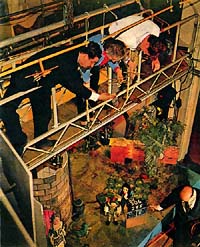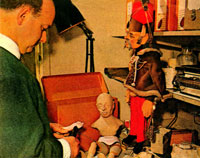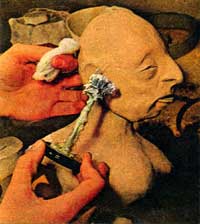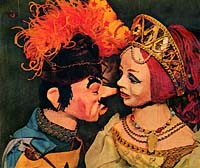|
Manipulating the Puppets
Initially Gordon tried adding the voice-actors
to the puppetry team, but found that this did not work out too well. His
idea had been that the person saying the lines would be the best person
to pull the strings. After finding that specialist puppeteers like
Audrey Atterbury, John Hardwick and Bob Bura put in the best puppet
performances, he reverted to the usual scheme in which the voice actors
just stuck to the dialogue. Gordon later wrote very appreciatively of
these very same puppeteers (in Ariel, Christmas 1962, which
featured the "Rubovian Legends" puppets on the cover)...
"At one time we tried using the actors who spoke
the lines for pulling the strings, but it was a failure...
"So now we use particularly sympathetic members of
the human race, known as puppeteers, to animate the figures. Only they can
understand the stresses and strains experienced by a puppet when playing a
large and demanding part. Only they can fully appreciate the fact that
their actor has crossed from the door to the table without tripping on the
carpet or fluffing his lip movement. Only they can experience the feeling
of supreme achievement when a puppet teapot successfully pours out a
puppet cup of tea--even if it is the tenth take.
"So next time you happen to see the
King of Rubovia playing chess, or Mr. Weatherspoon operating a particularly
complicated machine of his own invention,
please spare a thought for the puppeteers. Perched high above on the
bridge, with only a bird's-eye view of their charges, they are particularly
vulnerable to the heat of the lamps and the nattering of an over-demanding
producer."
|
|

(click for larger
image 105K) |
This is a scene from Bees
and Bellows in the Puppet Theatre studio in the BBC's then new
Television Centre, in 1962. Here we see Bob Bura (L), Audrey Atterbury, and
John Hardwick(R) on the bridge, ready for action, waiting for the soundtrack
dialogue to begin after Gordon Murray moves the clapper board out of the
view of the camera.
Points of Interest: If you look carefully you'll see that the
puppet controls are very similar to the control in Gordon Murray's sketch
shown above. Another photograph taken from
a different angle shows that the queen is actually not appearing in this
scene, but is instead hanging from her control, out of view of the film camera, two
feet up above the stage! This is more obvious in the next photograph,
below. Notice that her control is hanging on a hook,
higher up than the controls in the puppeteers' hands. Note the full use of
colour on the set, even though the filming was all done in B&W. The
puppet bridge is of sturdy welded tubular steel construction.
This picture originally appeared in
the article, The
Tiny World of Puppets, Look and Learn magazine
#38, 6th October 1962. Photograph by Rosemary
Mathews. Look and Learn was published by Fleetway
Publications Ltd. |
|
(click for larger
image 114K) |
Two more
views of the above scene, taken a short time later. These pictures appeared in
the article, A Peep at Rubovia, Girl comic, 17th March,
1962. |
|

(click for larger
image 114K) |
Gordon
Murray making one of his puppets, BBC Television Centre, 1962. He is
trimming the wire used to joint the puppet's arm to its body. The
Rubovia puppets were all made by Gordon, first sculpted in modeling
clay, from which
plaster moulds were made. The moulds were then used to
cast foam latex rubber. The limbs
were joined onto the puppet?s body with wire. The completed puppet
bodies were then turned over to designer Andrew Brownfoot, who
painted the faces, created the costumes, and dressed the puppets.
The typical working life of each puppet was about two years.
This picture appeared in
the article, The
Tiny World of Puppets, Look and Learn magazine
#38, 6th October 1962. Photograph by Rosemary
Mathews. Look and Learn was published by Fleetway
Publications Ltd. |
|

(click for larger
image 49K) |
Hair
being glued onto a puppet?s head. Each puppet was about two feet high (1/3 life-size) and weighed between six and eight
pounds.
This picture
appeared in the article, The
Tiny World of Puppets, Look and Learn magazine #38, 6th
October 1962. Photograph by Rosemary Mathews. Look and Learn was
published by Fleetway Publications Ltd. |
|

(click for larger
image 62K) |
Two of
Gordon Murray's puppets hanging in the storeroom,
waiting to appear before the camera. Although these are not Rubovia
puppets, the Rubovia puppets were quite similar to these in finish
and appearance. The male puppet was used in Gordon Murray's puppet
play, The Dancing Princess,
BBC Productions, 1962.
This picture appeared in
the article, The
Tiny World of Puppets, Look and Learn magazine
#38, 6th October 1962. Photograph by Rosemary
Mathews. Look and Learn was published by Fleetway
Publications Ltd. |
|
 |
|
|
 |
|
|
 |
|
|
